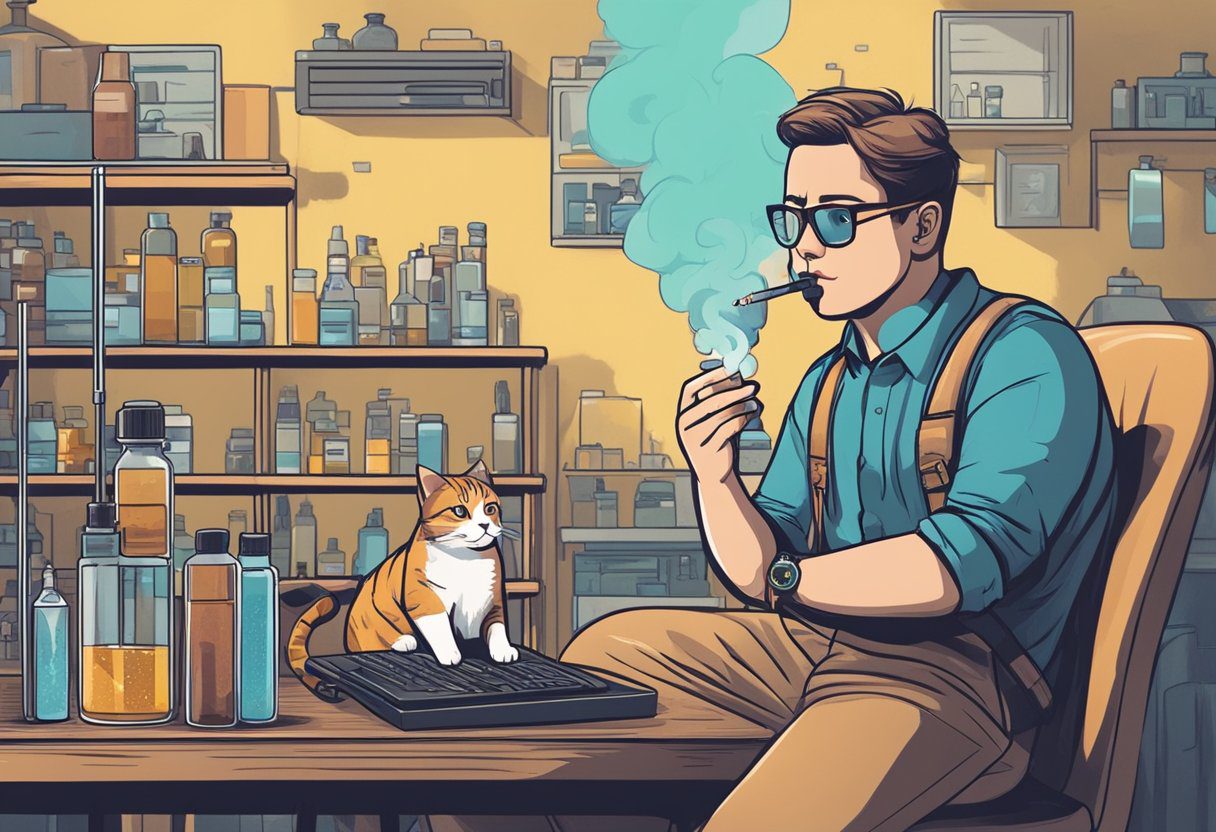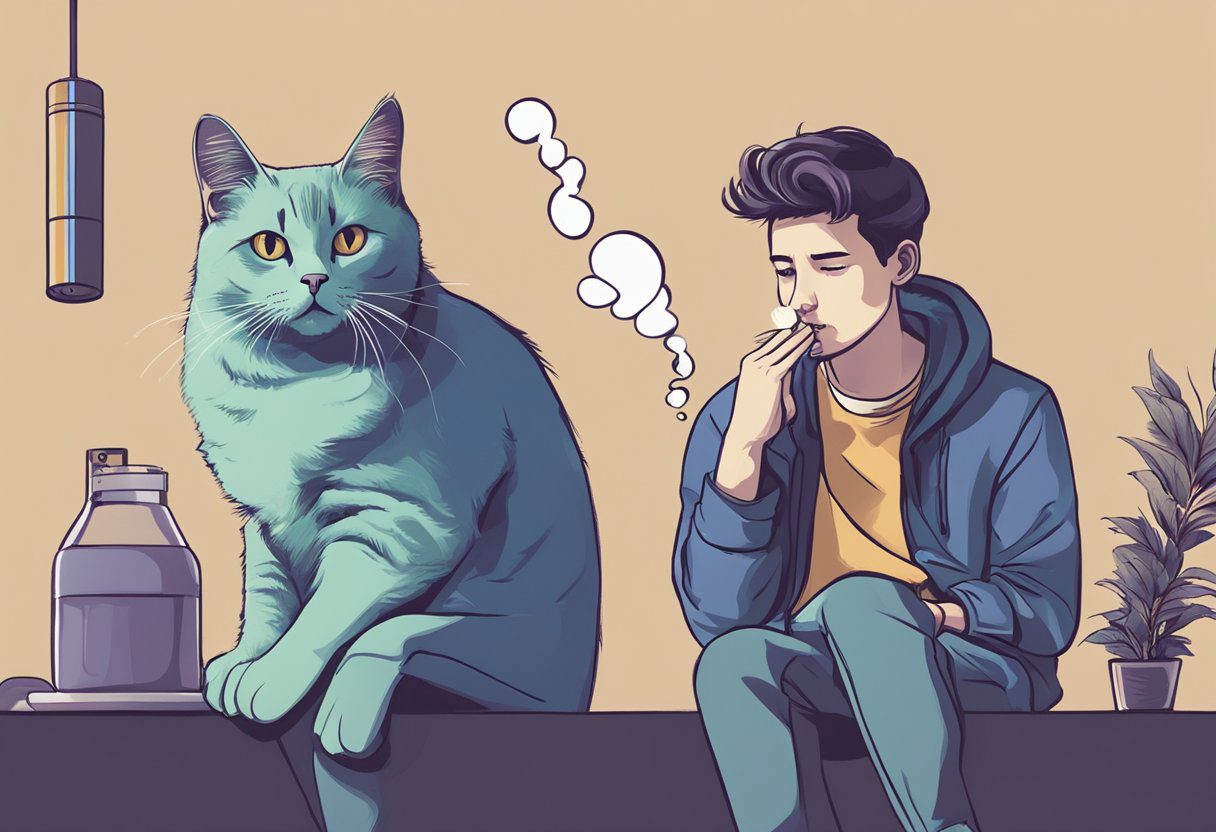Cats and Vaping: Ensuring Your Feline’s Safety While Vaping
Vaping has become increasingly popular over the years as an alternative to smoking. However, many cat owners are left wondering if it is safe to vape around their feline friends. While there is still much research to be done on the long-term effects of vaping on human health, there is even less research on the impact of vaping on pets’ health, including cats.
Vaping around cats can expose them to second-hand vapor, which can potentially harm them. Nicotine, a common component in e-cigarettes, is toxic to cats and can cause severe health problems. Additionally, the chemicals and flavorings used in e-cigarettes can also be harmful to cats. Therefore, it is crucial for cat owners who vape to understand the risks involved and take necessary precautions to ensure their cats are safe.
Contents
- 1 Understanding Vaping and Its Components
- 2 Effects of Vaping Around Cats
- 3 Chemical Hazards Associated with Vaping & Cats
- 4 Health Implications for Cats Exposed to Vaping
- 5 Guidance and Resources for Cat Owners
- 6 Frequently Asked Questions:
- 6.1 Can exposure to vape smoke lead to health issues in cats?
- 6.2 Is there a risk of nicotine poisoning in cats from second-hand vape smoke?
- 6.3 Could vaping indoors contribute to respiratory problems in cats?
- 6.4 Are there any known allergic reactions in cats to substances in vape smoke?
- 6.5 How does second-hand vape smoke affect a cat's overall well-being?
Key Takeaways
- Vaping around cats can expose them to second-hand vapor, which can potentially harm them.
- Nicotine, a common component in e-cigarettes, is toxic to cats and can cause severe health problems.
- It is crucial for cat owners who vape to understand the risks involved and take necessary precautions to ensure their cats are safe.
Understanding Vaping and Its Components
What Is Vaping
Vaping is a popular alternative to smoking that involves inhaling vapour produced by an electronic cigarette or vape pen. Unlike traditional cigarettes, vaping does not involve combustion, which means that there is no smoke or ash produced. Instead, the e-liquid is heated by a battery-powered heating element to create vapour that can be inhaled.
Components of E-Liquids
E-liquids are the liquids used in vaping devices that are heated to produce vapour. They typically contain a mixture of propylene glycol (PG) and vegetable glycerin (VG), which are both used as carriers for the flavourings and nicotine. PG is a colourless and odourless liquid that is widely used in food and medicine. VG is a natural sweetener that is derived from vegetable oil.
In addition to PG and VG, e-liquids also contain flavourings that are used to create different tastes and aromas. These flavourings are often natural and can range from fruity to sweet to savoury. Some e-liquids also contain nicotine, which is an addictive substance found in tobacco.
Vaping Devices and Supplies
Vaping devices come in various shapes and sizes, from disposable e-cigarettes to rechargeable vape pens. Disposable e-cigarettes are pre-filled with e-liquid and are designed to be used and then thrown away. Vape pens, on the other hand, are rechargeable and refillable, and can be used multiple times before needing to be refilled.
Vaping supplies include everything that is needed to vape, such as coils, tanks, batteries, and chargers. Coils are the heating elements that are used to heat the e-liquid and produce vapour. Tanks are the containers that hold the e-liquid, while batteries power the heating element. Chargers are used to recharge the batteries when they run out of power.
Overall, vaping is a safer alternative to smoking that involves inhaling vapour produced by an electronic cigarette or vape pen. E-liquids are heated to produce vapour that can be inhaled, and typically contain a mixture of propylene glycol and vegetable glycerin, flavourings, and sometimes nicotine. Vaping devices come in various shapes and sizes, from disposable e-cigarettes to rechargeable vape pens, and require supplies such as coils, tanks, batteries, and chargers.
Effects of Vaping Around Cats
Vaping is a popular alternative to smoking, but is it safe to vape around cats? While there is still much to learn about the long-term effects of vaping on human health, there is even less research on the impact of vaping on pets’ health, including cats. Here are some of the potential effects of vaping around cats.
Nicotine Poisoning in Cats
Nicotine is a toxic substance that can be harmful to cats if ingested or inhaled in large quantities. Cats are more sensitive to nicotine than humans, and even a small amount of nicotine can cause nicotine poisoning in cats. Symptoms of nicotine poisoning in cats include vomiting, diarrhea, tremors, seizures, and even death. Therefore, it is recommended to keep all vaping products out of reach of cats.
Inhalation Risks for Cats
Cats are obligate nose breathers, which means they rely on their noses to breathe. Vaping can cause irritation to the respiratory system of cats, leading to wheezing and coughing. Moreover, the aerosol produced by vaping can cause skin irritation in cats. Therefore, it is advisable to avoid vaping around cats and to provide adequate ventilation when vaping indoors.
Secondary Exposure Effects
Even if cats do not directly inhale the aerosol produced by vaping, they can still be exposed to it through secondary exposure. The aerosol produced by vaping can settle on surfaces in the environment, such as furniture and carpets, and can be ingested by cats when they groom themselves. Therefore, it is important to clean surfaces regularly and to avoid vaping in areas where cats spend a lot of time.
In conclusion, while there is still much to learn about the impact of vaping on pets’ health, including cats, it is advisable to avoid vaping around cats to prevent potential health risks.
Chemical Hazards Associated with Vaping & Cats
Propylene Glycol and Vegetable Glycerin Concerns
Propylene glycol and vegetable glycerin are two common ingredients in e-liquids. While they are generally considered safe for humans, there are some concerns about their potential effects on cats. Propylene glycol can cause irritation to the eyes and respiratory system, while vegetable glycerin can cause gastrointestinal upset. It’s important to note that these effects are generally mild and occur at much higher doses than what is typically found in vape aerosol.
In summary, while vaping is generally considered a safer alternative to smoking tobacco, it’s important to be aware of the potential risks when it comes to vaping around cats. The chemical hazards associated with vaping can pose a risk to cats if they are exposed over a long period of time. By practicing responsible vaping, including using safe devices, avoiding excessive vaping, and ensuring proper ventilation, the risks to cats can be minimised.
Health Implications for Cats Exposed to Vaping
Vaping is often considered a safer alternative to smoking, but it is important to note that it is not completely harmless. As vaping becomes increasingly popular, many pet owners are concerned about the impact of vaping on their furry feline friends. While there is limited research on the impact of vaping on cats, it is important to be aware of the potential health implications.
Respiratory Issues in Cats
One of the main concerns for cats exposed to vaping is the risk of respiratory issues. Vaping can cause inflammation in the lungs and lead to chronic bronchitis. Cats are particularly susceptible to respiratory issues, and exposure to secondhand smoke or vapor can exacerbate existing respiratory problems.
Gastrointestinal Disturbances
Cats exposed to vaping may also experience gastrointestinal disturbances such as vomiting and diarrhoea. These symptoms may be caused by the ingestion of toxic chemicals found in e-cigarettes. If you observe any of these signs in your cat, it is important to contact your veterinarian immediately.
Long-Term Health Risks
Long-term exposure to vaping may lead to more serious health risks in cats, including seizures and high blood pressure. Nicotine in e-cigarettes can increase blood pressure and heart rate, which can lead to heart disease in cats. Additionally, there have been reports of serious lung damage and even death linked to vaping.
It is important to note that there is still much to learn about the long-term effects of vaping on human health, and even less research on the impact of vaping on pets’ health, including cats. As a responsible pet owner, it is important to minimise your cat’s exposure to secondhand smoke or vapour.
Guidance and Resources for Cat Owners
When it comes to vaping around cats, it is important for pet owners to be informed and take necessary precautions to ensure the safety of their furry friends. Here are some resources and guidance for cat owners to help keep their pets safe:
Consulting the Pet Poison Helpline
The Pet Poison Helpline is a valuable resource for pet owners who suspect their pets have ingested something toxic. The helpline is staffed by veterinary professionals who can provide guidance on what to do in case of an emergency. If a cat has ingested e-liquid or is exhibiting symptoms such as vomiting, diarrhoea, or lethargy after exposure to vaping, it is important to contact the Pet Poison Helpline immediately.
Contacting Animal Poison Control Centers
In addition to the Pet Poison Helpline, there are several Animal Poison Control Centers that can provide assistance to pet owners in case of an emergency. These centers have veterinarians and toxicologists on staff who can provide information and guidance on what to do if a pet has ingested something toxic. It is important to have these numbers on hand in case of an emergency.
It is important to note that while vaping is generally considered safer than smoking, it can still pose a risk to pets. Cats, in particular, are sensitive to the chemicals present in e-liquids and can experience adverse reactions such as vomiting, diarrhea, and lethargy. Therefore, it is important for pet owners to take necessary precautions when vaping around their pets.
Some tips for pet-friendly vaping include keeping e-liquids out of reach of pets, using closed tanks to prevent spills, and vaping in a well-ventilated area away from pets. By following these guidelines and consulting the appropriate resources, pet owners can enjoy vaping while keeping their furry friends safe.
Frequently Asked Questions:








Leave a Reply